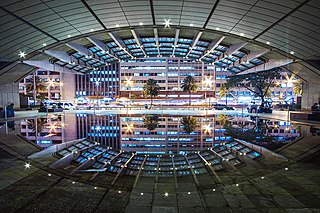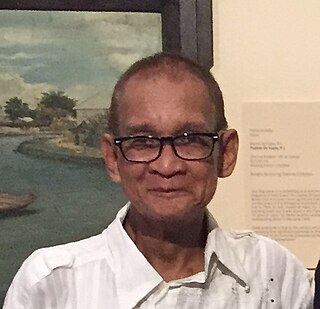
Makati, officially the City of Makati, is a highly urbanized city in the National Capital Region of the Philippines, known for being one of the leading financial center in the country. As of 2013, the city has the highest concentration of multinational and local corporations in the Philippines. Major banks, corporations, department stores as well as foreign embassies are based in Makati. Makati is also known for being a major cultural and entertainment hub in Metro Manila. According to the 2020 census, it had a population of 629,616 people, making it as the 47th most populous city in the country and ranked as the 43rd most densely populated city in the world with 19,336 inhabitants per square kilometer or 50,080 inhabitants per square mile. In 2023, ten eastern barangays were removed from Makati's jurisdiction as a result of the Makati–Taguig boundary dispute ruling, resulting in a reduction of the city's population to 292,743. Although its population was just above half a million, the daytime population of the city is estimated to be more than three million during a typical working day because of the large number of people who go to the city to work, shop, and do business.

Ayala Corporation is the publicly listed holding company for the diversified interests of the Ayala Group. Founded in the Philippines by Domingo Róxas and Antonio de Ayala during Spanish colonial rule, it is the country's oldest and largest conglomerate. The company has a portfolio of diverse business interests, including investments in retail, education, real estate, banking, telecommunications, water infrastructure, renewable energy, electronics, information technology, automotive, healthcare, management, and business process outsourcing. As of November 2015, it is the country's largest corporation in terms of assets ($48.7B).
The Zóbel de Ayala clan is a prominent Filipino family of Spanish and German descent who were the founders of Ayala y Compañía and patrons of the Premio Zóbel literary awards. The clan is directly descended from Jacobo Zóbel y Zangroniz (1842–1896) and Trinidad de Ayala (1856–1918). Ayala y Compañía traces its origins to Casa Róxas, a business partnership established in 1834 between Domingo Róxas (1792–1843) and Antonio de Ayala (1803–1876).

The Cultural Center of the Philippines Foundation, Inc. is a government-owned and controlled corporation established to preserve, develop and promote arts and culture in the Philippines. The CCP was established through Executive Order No. 30 s. 1966 by President Ferdinand Marcos. Although an independent institution of the Philippine government, it receives an annual subsidy and is placed under the National Commission for Culture and the Arts for purposes of policy coordination. The CCP is headed by an 11-member Board of Trustees, currently headed by Chairperson Margarita Moran-Floirendo. Its current president is Arsenio Lizaso.

Fernando Amorsolo y Cueto was a portraitist and painter of rural Philippine landscapes. Nicknamed the "Grand Old Man of Philippine Art," he was the first-ever to be recognized as a National Artist of the Philippines. He was recognized as such for his "pioneering use of impressionistic technique" as well as his skill in the use of lighting and backlighting in his paintings, "significant not only in the development of Philippine art but also in the formation of Filipino notions of self and identity."

Leandro Valencia Locsin, Sr., also known by the initials LVL and the nickname "Lindy", was a Filipino architect, artist, and interior designer known for his use of concrete, floating volume and simplistic design in his various projects. An avid collector, he was fond of modern painting and Chinese ceramics. He was proclaimed a National Artist of the Philippines for Architecture in 1990 by the late President Corazon C. Aquino.
Jaime Zóbel de Ayala y Pfitz, also known as Jaime Zóbel, is a Filipino businessman who served as the chairman of the Ayala Corporation from 1984 to 2006 and as its president from 1984 to 1994. Presently, he holds the honorary title as "Chairman Emeritus".

The Parish of the Holy Sacrifice, also known as the Church of the Holy Sacrifice, is a landmark Roman Catholic chapel on the University of the Philippines Diliman campus. It belongs to the Roman Catholic Diocese of Cubao and its present parish priest is Rev. Fr. Jose S. Tupino III. More popularly known as the UP Chapel, the church was constructed under the supervision of Fr. John P. Delaney, who began ministering to the spiritual needs of the campus in 1947.

Ambeth R. Ocampo is a Filipino public historian, academic, cultural administrator, journalist, author, and independent curator. He is best known for his definitive writings about Philippines' national hero José Rizal and on topics in Philippine history and Philippine art through Looking Back, his bi-weekly editorial page column in the Philippine Daily Inquirer.

Don Fabián de la Rosa y Cueto was a Filipino painter. He was the uncle and mentor to the Philippines' national artist in painting, Fernando Amorsolo, and to his brother Pablo. He is regarded as a "master of genre" in Philippine art.
Fernando Zóbel de Ayala y Montojo Torrontegui, also known as Fernando M. Zóbel, was a Spanish Filipino painter, businessman, art collector and museum founder.

The Ateneo Art Gallery is a museum of modern art of the Ateneo de Manila University. It is the first of its kind in the Philippines. It serves as an art resource for the university community and the general public as well. The Gallery is located at the Arts Wing, Areté, Ateneo de Manila University, Katipunan Avenue, Loyola Heights, Quezon City.
Enrique Jacobo Pedro Luis Plácido Zóbel de Ayala was a Spanish-born industrialist and philanthropist who became the first patriarch of the Zóbel de Ayala family. He was also one of the leaders in the Philippine Falange during the 1930s and 1940s.

The Makati Central Business District is a financial and central business district in the Philippines located in the heart of Makati in Metro Manila. It is politically known as "Central Cluster" in the West District of Makati. It is different from the Makati civic center known as "Makati Poblacion" which is situated at the northeast portion of the district. It is bounded by EDSA, Amorsolo Street, Ayala Avenue, Gil Puyat Avenue, Osmeña Highway, Zobel Roxas Street, Ocampo Street, Metropolitan Avenue, Nicanor Garcia Street, Kalayaan Avenue, Makati Avenue, Anza Street, Polaris Street, Orion Street, Mercedes Street, Amapola Street and Estrella Street. The whole district occupies barangays of San Antonio, San Lorenzo, Bel-Air, and Urdaneta.

The Ayala Triangle Gardens is a 2-hectare (4.9-acre) landscaped urban park in Makati, Metro Manila, Philippines. It is a triangular public garden and courtyard in the center of the Makati Central Business District. It was named after its owner and developer Ayala Land, and opened to the public in November 19, 2009. Inspired by Hyde Park in London, the park, which is dotted with palms, acacia trees, and tropical foliage, is considered one of the few "green" areas in Makati.
Anita Magsaysay-Ho was a Filipina painter who specialized in Social Realism and post-Cubism in regard to women in Filipino culture. Magsaysay-Ho's work appeals to Modernism by utilizing more abstract designs and styles rather than realistic approaches. She was the only female member of the "Thirteen Moderns," a standing group of Filipino modernist artists, and in 1958 was chosen by a panel of experts as one of the six major painters of the country's history. The most famous work of Magsaysay-Ho are subject to the beauty of Filipino women dealing with everyday issues. Collections of her artwork can be found in museums around the Philippines.

The Mandarin Oriental Manila was a hotel along Makati Avenue in Makati, Metro Manila, Philippines, managed by the Mandarin Oriental Hotel Group and designed by National Artist Leandro Locsin.

Ramon Nazareth Villegas more popularly known as Mon Villegas or Boy Villegas, was a Filipino curator, art historian, jeweler, author, antiquities dealer, and poet. He was best known for chronicling the history of Philippine art and antiquities in various publications in both the Philippines and overseas. Villegas ran his own antique shop called Yamang Katutubo Artifacts and Crafts, which featured Philippine jewelry and antiques that closed on his death in 2017.
Nena Saguil was a Filipina artist of modernist and abstract paintings and ink drawings. She was most known for her cosmic, organic, and spiritual abstract works depicting internal landscapes of feeling and imagination. For these, Saguil is considered a pioneer of Filipino abstract art.

Santiago Albano Pilar more popularly known as Jak Pilar, was a Filipino art historian, curator, and author. He was best known for chronicling Philippine art centered on the 19th and the 20th century in numerous publications in both the Philippines and overseas.




















